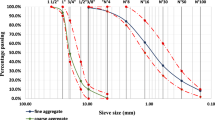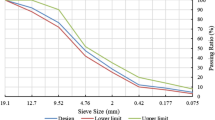Abstract
Various aggregate gradations are recommended in various guidelines/specifications for different types of asphalt mixes. These aggregate gradations have primarily evolved through experimental studies and experience on their field performances. Given a size range of aggregates, numerous aggregate gradations (and thereby numerous asphalt mixes) are possible. It is essentially a cumbersome and time consuming task to study the laboratory or field performances for all such possible asphalt mixes. The objective of the present work is to perform a micromechanical analyses on various asphalt mixes generated from computer simulated aggregate gradations. A hierarchical modeling scheme is used in the present work, where the asphalt mix is modeled as elastic-visco-plastic matrix with aggregates as rigid particulate intrusions with large volume fraction. In this process, a large number mixes can be simulated for their mechanical responses and some of them can be chosen for further laboratory verification. It is expected that such a process would save a considerable time and effort while finalizing a suitable gradation for the mix design.
Similar content being viewed by others
References
Abbas, A. R., Papagiannakis, A. T., and Masad, E. (2004). “Linear and non-linear viscoelastic analysis of the micro structure of asphalt concrete.” Journal of Materials in Civil Engineering, ASCE, Vol. 16, No. 2, pp. 133–139.
Abdullah, W. S., Obaidat, M. T., and Abu-Sa’da, N. M. (1998). “Influence of aggregate type and gradation on voids of asphalt concrete pavement.” Journal of Materials in Civil Engineering, ASCE, Vol. 10, No. 2, pp. 76–85.
Anderson, R. M. and Bahia, H. U. (2002). “Evaluation and selection of aggregate gradations for asphalt mixtures using Superpave.” Transportation Research Record 1583, TRB, National Research Council, Washington, D.C., pp. 91–97.
Bandyopadhyaya, R. (2005). Micromechanical analysis of asphalt mix, Master’s Thesis, Department of Civil Engineering, Indian Institute of Technology Kanpur, India.
Bandyopadhyaya, R., Das, A., and Basu, S. (2008). “Numerical simulation of mechanical behaviour of asphalt mix.” Construction and Building Materials, Vol. 22, No. 6, pp. 1051–1058.
Berthelot, C. F., Allen, D. H., and Searcy, C. R. (2003). “Method for performing accelerated characterization of viscoelastic constitutive behavior of asphaltic concrete.” Journal of Materials in Civil Engineering, ASCE, Vol. 15, No. 5, pp. 496–505.
Cebon, D. and Cheung, C. Y. (1997a). “Deformation mechanism for pure bitumen.” Journal of Materials in Civil Engineering, ASCE, Vol. 9, No. 3, pp. 117–129.
Cebon, D. and Cheung, C. Y. (1997b). “Experimental study of pure bitumens in tension, compression and shear.” Journal of Rheology, Vol. 41, No. 1, pp. 45–73.
Chen, J., Pan, T., and Huang, X. (2011). “Numerical investigation into the stiffness anisotropy of asphalt concrete from a microstructural perspective.” Construction and Building Materials, Vol. 25, No. 7, pp. 3059–3065.
Das, A., Deol, M. S., Ohri, S., and Pandey, B. B. (2004). “Evolution of non-standard bituminous mix — a study on Indian specification.” The International Journal of Pavement Engineering, Vol. 5, No. 1, pp. 39–46.
Dunhill, S. T., Airy, G. D., Collop, A. C., and Scarpas, A. (2006). “Advanced constitutive modeling of bituminous materials.” The International Journal of Pavement Engineering, Vol. 7, No. 3, pp. 153–165.
Dziugys, A. and Peters, B. (2001). “A new approach to detect the contact of two-dimensional elliptical particles.” International Journal for Numerical and Analytical Methods in Geomechanics, Vol. 25, No. 15, pp. 1487–1500.
Gopalakrishnan, K. and Sashidhar, N. (2006). “Structural characteristics of three-dimensional random packing of aggregates with wide size distributions.” International Journal of Information Technology, Vol. 3, No. 3, pp. 201–208.
Hand, A. J., Stiady, J. L., White, T. D., Noureldin, A. S., and Galal, K. (2001). “Gradation effects on hot-mix asphalt performance.” Transportation Research Record 1767, TRB, National Research Council, Washington, D.C., pp.152–157.
Hashin Z. and Shtrikman S. (1963). “A variational approach to the theory of the elastic behavior of multiphase materials.” Journal of Mechanics and Physics of Solids, Vol. 11, pp. 127–140.
Holley, I. B. (2003). “How asphalt paving came to the urban United States.” Technology and Culture, Vol. 44, No. 4, pp. 703–733.
Huang, B., Mohammad, L. M. and Wathugala, G. W. (2004). “Application of a temperature dependent viscoplastic hierarchical single surface model for asphalt mixtures.” Journal of Materials in Civil Engineering, ASCE, Vol. 16, No. 2, pp. 147–154.
Isayev, A. I., Zolotarev, V. A., and Vinogradov, G. V. (1975). “Viscoelastic properties of bitumens in continuous and cyclic deformation.” Rheologica Acta, Vol. 14, No. 1975, pp. 135–144.
Kandhal, P. S. and Mallick, R. B. (2002). “Effect of mix gradation on rutting potential of dense-graded asphalt mixtures.” Transportation Research Record 1767, TRB, National Research Council, Washington, D.C., pp. 146–151.
Karakouzian, M., Dunning, M. R., Dunning, R. L., and Stegeman, J. D. (1996). “Performance of hot mix asphalt using coarse and skip graded aggregates.” Journal of Materials in Civil Engineering, ASCE, Vol. 8, No. 2, pp. 101–107.
Kim, Y.-R., Allen, D. H., and Little, D. N. (2007). “Computational constitutive model for predicting non-linear visco-elastic damage and fracture failure of asphalt concrete mixtures.” Int. J. Geomech, ASCE, Vol. 7, No. 2, pp. 102–110.
Kim, Y.-R. and Little, D. N. (2004). “Linear viscoelastic analysis of asphalt mastics.” Journal of Materials in Civil Engineering, ASCE, Vol. 16, No. 2, pp. 122–132.
Lakes R. S. (1998). Viscoelastic solids, CRC Press, New York.
Lakes, R. S., Kose, S., and Bahia, H. U. (2002). “Analysis of high volume fraction irregular particulate damping composites.” Journal of Engineering Materials and Technology, Vol. 124, No. 2, pp. 174–178.
Lee, H. J. and Kim, Y. R. (1998). “Viscoelastic constitutive model for asphalt concrete under cyclic loading.” Journal of Engineering Mechanics, Vol. 124, No. 1, pp. 32–40.
Masad, E. and Niranjanan, S. (2002). “Microstructural finite-element analysis of influence of localized strain distribution on asphalt mix properties.” Journal of Engineering Mechanics, Vol. 128, No. 10, pp. 1106–1115.
Mitra, K. (2006). Experimental and numerical study on mechanical behaviour of asphalt mix, Masters Thesis, Department of Civil Engineering, Indian Institute of Technology, Kanpur, India.
Mitra, K., Das, A., and Basu, S. (2012). “Mechanical behaviour of asphlat mix: An experimental and numerical study.” Construction and Building Materials, Vol. 27, No. 1, pp. 545–552.
Newtson, C. M. and Turner, J. P. (1993). “Effects of aggregate top size on bituminous concrete.” Journal of Materials in Civil Engineering, ASCE, Vol. 5, No. 4, pp. 531–543.
Ontario Provincial Standard Specification (2005). OPSS 1151, Material Specification for Superpave and Stone Mastic Asphalt Mixtures, Ontario, Canada.
Panneerselvam, D. and Panoskaltsis, V. P. (2005). “Numerical implementation of a hyperelastic-viscoplastic damage model for asphalt concrete materials and pavements.” Asphalt Concrete: Simulation, Modeling, and Experimental Characterization Proceedings of the R. Lytton Symposium on Mechanics of Flexible Pavements, Editors: Masad, E., Panoskaltsis, V. P. and Wang, L., Baton Rouge, pp. 61–72.
Prowell, B. D., Watson, D. E., Hurley, G. C., and Brown, E. R. (2009). Evaluation of Stone Matrix Asphalt (SMA) for airfield pavements, AAPTP. 04-04, Final Report, Airfield Asphalt Pavement Technology Program, Auburn University.
Roberts, F. L., Mohammad, L. M., and Wang, L. B. (2000). “History of hot-mix asphalt mix design in United States.” Journal of Materials in Civil Engineering, ASCE, Vol. 14, No. 4, pp. 279–293.
Sadd, M. H., Dai, Q., Parameswaran, V., and Shukla, A. (2004). “Microstructural simulation of asphalt materials: Modeling and experimental studies.” Journal of Materials in Civil Engineering, ASCE, Vol. 16, No. 2, pp. 107–115.
Sánchez-Leal, F. J. (2007) “Gradation chart for asphalt mixes: Developments.” Journal of Materials in Civil Engineering, Vol. 19, No. 2, pp. 185–197.
Singh, A. (2007). Effect of aggregate gradation on the mechanical property of asphalt mix — A numerical study, Master’s Thesis, Department of Civil Engineering, Indian Institute of Technology Kanpur, India.
Sousa, J. B., Pais, J. C., Prates, M., Barros, R., Langlois, P., and Leclerc, A. M. (1998). “Effect of aggregate gradation on fatigue life of asphalt concrete mixes.” Transportation Research Record 1630, TRB, National Research Council, Washington, D.C., pp. 62–68.
Suquet, P. M. (1993). “Overall potentials and external surfaces of power law or ideally plastic composites.” Journal of Mechanics and Physics of Solids, Vol. 41, No. 6, pp. 981–1002.
Tashman, L., Masad, E., Little, D. N., and Zbib, H. (2005a). “A microstructure-based viscoplastic model for asphalt concrete.” Journal of Plasticity, Vol. 21, No. 9, pp. 1659–1685.
Tashman, L., Masad, E., Little, D. N., Zbib, H., and Kaloush, K. (2005b). “Microstructural viscoplastic continuum model for permanent deformation in asphalt pavements.” Journal of Engineering Mechanics, ASCE, Vol. 131, No. 1, pp. 48–57.
Uzan, J. (2005). “Viscoelastic-viscoplastic model with damage for asphalt concrete.” Journal of Materials in Civil Engineering, ASCE, Vol. 17, No. 5, pp. 528–534.
Vavrik, W. R., Huber, G., Pine, W. J., Carpenter, S. L., Bailey, R. (2002a). “Bailey method for gradation selection in hot-mix asphalt mixture design.” Transportation Research Circular, Number EC044, http://onlinepubs.trb.org/onlinepubs/circulars/ec044.pdf, Last accessed July 2010.
Vavrik, W. R., Pine, W. J., and Carpenter, S. H. (2002b). “Aggregate blending for asphalt mix design: Bailey method.” Transportation Research Record, 1789, TRB, National Research Council, Washington, D.C., pp. 146–153.
You, Z. and Dai, Q. (2007). “Review of advances in micromechanical modeling of aggregate-aggregate interactions in asphalt mixtures.” Canadian Journal of Civil Engineering, Vol. 34, No. 2, pp. 239–252.
Author information
Authors and Affiliations
Corresponding author
Rights and permissions
About this article
Cite this article
Singh, A., Das, A. & Basu, S. A numerical study on the effect of aggregate gradation on mechanical response of asphalt mix. KSCE J Civ Eng 16, 594–600 (2012). https://doi.org/10.1007/s12205-012-1391-1
Received:
Revised:
Accepted:
Published:
Issue Date:
DOI: https://doi.org/10.1007/s12205-012-1391-1




